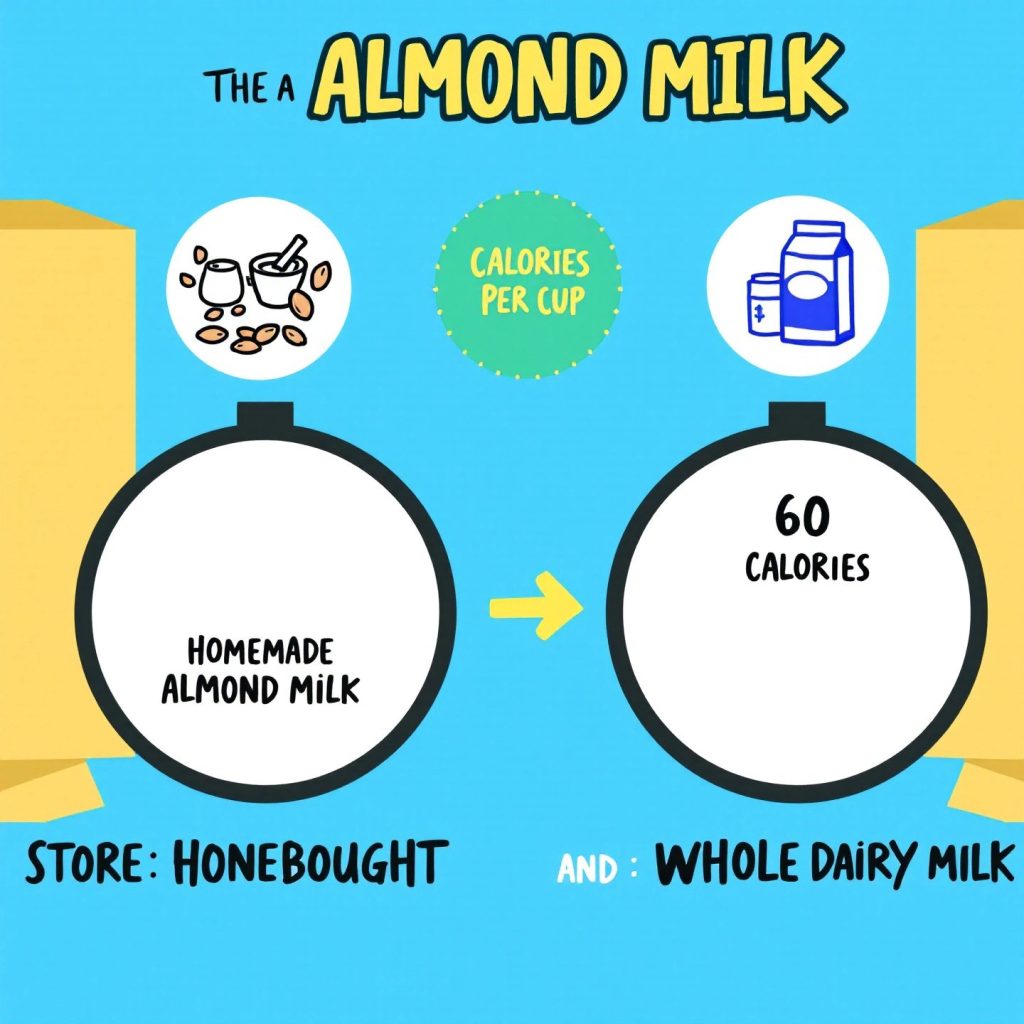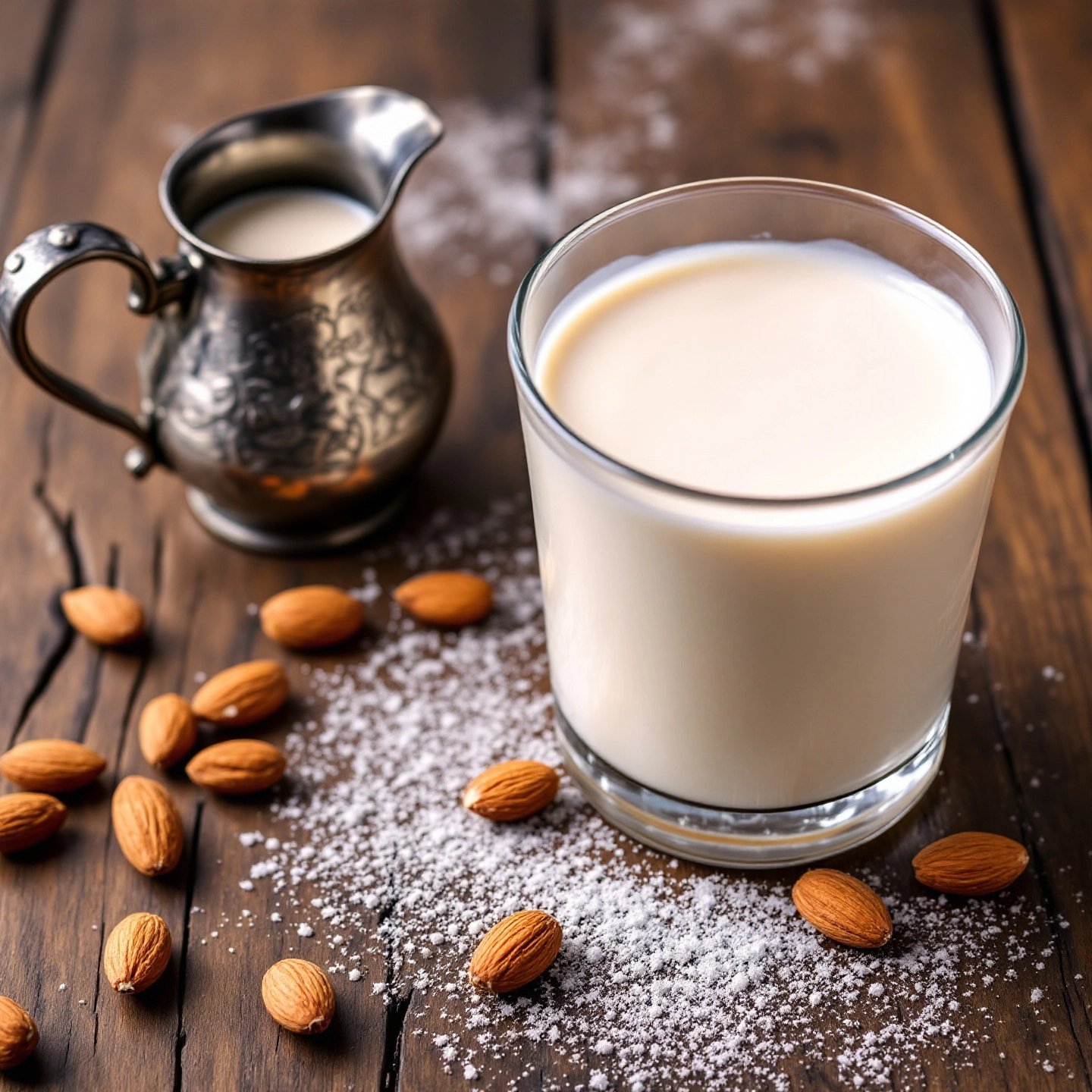Introduction: The Rise of Homemade Almond Milk
In recent years, homemade almond milk has surged in popularity as a tasty and nutritious alternative to traditional dairy milk. For many health-conscious individuals and those with dietary restrictions, this plant-based milk offers a delightful solution. It’s like discovering a new favorite book that you can’t put down—once you start, you’re hooked! The appeal lies not only in its creamy texture and mild, nutty flavor but also in its impressive nutritional profile.
Homemade almond milk is particularly attractive to those who are lactose intolerant or following a vegan lifestyle. It’s a bit like finding a pair of shoes that fit perfectly—comforting and just right for you. Unlike its store-bought counterparts, making almond milk at home allows you to control the ingredients, ensuring a pure and natural product. This means no unwanted additives or preservatives, just the wholesome goodness of almonds and water.
As we dive deeper into this topic, we’ll explore the calorie content of homemade almond milk, its nutritional benefits, and why it might just be the perfect addition to your diet. So, whether you’re looking to manage your calorie intake or simply enjoy a refreshing drink, homemade almond milk could be your new go-to. Stay tuned as we unravel the many reasons why this delightful beverage is gaining fans across the globe.

Calorie comparison of homemade almond milk versus other milk types (AI-generated)
Calorie Content of Homemade Almond Milk
When it comes to understanding homemade almond milk calories, it’s like piecing together a puzzle. The calorie count can vary based on several factors, such as the almond-to-water ratio and any added ingredients like sweeteners or flavorings. Typically, a cup of homemade almond milk contains about 50 to 60 calories, which is significantly lower than the 150 calories found in a cup of whole milk. This makes it an appealing choice for those watching their waistlines.
Comparing it to store-bought versions can be a bit like comparing apples to oranges. Store-bought almond milk often contains added sugars and preservatives, which can bump up the calorie count. On the other hand, homemade almond milk allows you to control exactly what goes into your glass. For example, using a 1:3 ratio of almonds to water, you’ll likely end up with a creamy texture and a calorie count on the lower end of the spectrum.
Different recipes and preparation methods can also influence the final calorie tally. Some folks might prefer to add a dash of vanilla or a couple of dates for sweetness, which can slightly increase the calories. But hey, a little indulgence never hurt anyone, right? If you’re making it for a specific dietary plan, consider these variations and how they might fit into your daily intake.
Ultimately, homemade almond milk offers a deliciously low-calorie alternative to traditional dairy milk, making it a smart option for anyone aiming to maintain or lose weight. So, next time you’re pondering your milk choices, remember that homemade almond milk is not just a tasty option but also a calorie-conscious one. As we move forward, let’s dive into the nutritional profile of this delightful drink.
Nutritional Profile of Homemade Almond Milk
Peeling back the layers of homemade almond milk’s nutritional profile is like opening a treasure chest of health benefits. While it may not pack a protein punch like cow’s milk, with only about 1 gram of protein per cup, it shines in other areas. Almond milk is rich in healthy fats, which are essential for heart health and keeping your skin glowing. Imagine sipping on a glass of liquid gold—it’s not far from the truth!
Vitamins and Minerals Galore
Homemade almond milk is a good source of vitamin E, an antioxidant that helps protect your cells from damage. It’s like having a tiny superhero in your drink, fighting off free radicals. Additionally, it contains small amounts of calcium, magnesium, and potassium, which are crucial for bone health and muscle function. While it doesn’t quite match the nutrient density of dairy milk, it offers a clean, additive-free option that many find appealing.
Comparing Nutritional Value
When stacked against store-bought almond milk, the homemade version often comes out ahead in terms of purity. Store-bought varieties can contain additives and preservatives to extend shelf life, not to mention added sugars that can sneak up on you like a ninja. By making almond milk at home, you dodge these hidden ingredients, ensuring a more wholesome beverage.
However, it’s worth noting that homemade almond milk might fall short in certain nutrients that are often fortified in commercial versions, like vitamin D and B12. If you’re relying on almond milk as a significant part of your diet, consider fortifying it with these vitamins or supplementing them through other dietary sources.
Customizing for Nutritional Needs
For those looking to boost the nutritional content of their homemade almond milk, there are creative solutions. You can blend in a handful of other nuts or seeds, such as chia or flaxseeds, to enhance the protein and omega-3 fatty acid content. Or, if you’re like me and enjoy a little culinary experimentation, try adding a pinch of sea salt or a splash of vanilla extract for extra flavor without additional calories.
In summary, homemade almond milk offers a clean, customizable, and nutritious alternative to both dairy and commercially prepared almond milk. While it may require a bit more effort, the control over ingredients and the absence of unwanted additives make it a rewarding choice. As we continue, let’s explore the health benefits that make this nutty beverage a favorite among many.

Almond milk supports heart health with its low cholesterol content (AI-generated)
Health Benefits of Homemade Almond Milk
Drinking homemade almond milk is like giving your body a gentle hug from the inside. This nutty beverage is packed with benefits that can support various aspects of your health. One of the most significant advantages is its potential role in promoting heart health. Almond milk is naturally free of cholesterol and saturated fats, making it a heart-friendly option. It’s like swapping out a high-calorie dessert for a refreshing fruit salad—your heart will thank you!
Another perk of homemade almond milk is its suitability for weight management. With its lower calorie content compared to dairy milk, it’s a great choice for those looking to shed a few pounds. It’s like choosing a brisk walk over a taxi ride—small changes add up over time. Plus, unsweetened almond milk is low in carbs, which can be beneficial for those managing their blood sugar levels. This makes it a smart choice for individuals with diabetes or anyone keeping an eye on their carb intake.
For those who are lactose intolerant, almond milk is a dream come true. It’s naturally lactose-free, offering a creamy alternative to dairy without the digestive discomfort. Imagine enjoying a creamy latte without the worry—sounds pretty good, right? Additionally, almond milk is a popular choice among those following plant-based diets. It fits seamlessly into vegan and vegetarian lifestyles, providing a versatile base for smoothies, cereals, and more.
However, it’s important to consider a few potential drawbacks. Homemade almond milk may lack certain nutrients found in fortified store-bought versions, such as vitamin D and B12. If these are concerns, you might want to supplement your diet with other sources of these vitamins. Also, individuals with nut allergies should steer clear of almond milk to avoid allergic reactions.
Overall, the benefits of homemade almond milk make it a valuable addition to many diets. Whether you’re sipping it straight or using it as a base for your favorite recipes, it’s a delicious way to nourish your body. Next, we’ll explore how you can make this delightful beverage at home, ensuring the perfect blend of flavor and nutrition.
Making Almond Milk at Home: Tips and Tricks
Creating your own almond milk at home is like crafting a personalized masterpiece in your kitchen. It’s surprisingly simple and requires just a few ingredients: almonds, water, and your choice of sweeteners or flavors. Let’s dive into the process, which is as easy as pie—well, maybe easier since there’s no baking involved!
First, soak your almonds overnight in water. This step is crucial as it softens the nuts, making them easier to blend and enhancing the milk’s creaminess. Once soaked, drain and rinse the almonds thoroughly before adding them to a blender with fresh water. A standard ratio is about one cup of almonds to three cups of water, but feel free to adjust based on your desired thickness.
Flavorful Variations
Now, here’s where the fun begins. You can add a few dates for natural sweetness, which will slightly increase your homemade almond milk calories but also add a delightful flavor. For a twist, try tossing in a dash of vanilla extract or a sprinkle of cinnamon. If you’re feeling adventurous, blend in some cacao powder for a chocolatey treat that feels like a hug in a mug.
Straining and Storage
After blending, pour the mixture through a nut milk bag or a fine mesh strainer into a bowl, squeezing to extract all the liquid. This step is akin to squeezing the last bit of toothpaste from the tube—don’t waste a drop! Transfer the milk to an airtight container and store it in the fridge, where it should last about 3-5 days. Remember to give it a good shake before each use, as separation is natural.
Overcoming Common Challenges
Homemade almond milk can sometimes separate or spoil quickly. To prevent this, ensure all equipment is sterilized before use, and always store your almonds and milk in the fridge. If you find the milk too thin, reduce the water ratio or try blending longer. And if you’re wondering about the leftover almond pulp, don’t toss it! It can be repurposed into almond flour or used in baking.
Making almond milk at home not only allows you to tailor the flavor and consistency to your liking but also ensures a fresh, additive-free beverage. As we continue, let’s compare homemade almond milk with its store-bought counterpart to see which might suit your lifestyle better.

Comparing homemade and store-bought almond milk for purity and nutrition (AI-generated)
Homemade vs. Store-Bought Almond Milk: A Comparison
Choosing between homemade and store-bought almond milk is like deciding between a homemade pie and a store-bought one. Both have their perks, but the choice often boils down to personal preference and priorities.
Nutritional Value and Taste
Homemade almond milk typically boasts a higher nutritional value because you control the almond content. This means more healthy fats, vitamins, and minerals in every sip. Store-bought versions often contain only a small percentage of almonds, sometimes as low as 2.5%, with the rest being water and additives. These additives, such as thickeners and preservatives, might help with texture and shelf life, but they don’t add nutritional value. In terms of taste, homemade almond milk often wins hands down, offering a richer, more authentic flavor that can be customized with natural sweeteners and spices.
Cost and Environmental Impact
From a cost perspective, making your own almond milk can be more economical in the long run. You’re not paying for packaging or marketing—just the raw ingredients. Plus, you avoid the hidden cost of buying what is essentially expensive water with minimal nuts. Environmentally, homemade almond milk also has the edge. By reducing packaging waste and transportation emissions, it leaves a lighter footprint on our planet. Store-bought almond milk, while convenient, often comes with a higher environmental cost due to production and distribution processes.
Additives and Fortification
A significant downside to commercial almond milk is the inclusion of additives like carrageenan and emulsifiers, which can cause digestive issues for some people. Homemade versions, on the other hand, are free from these additives, providing a cleaner, more natural product. However, store-bought almond milk is often fortified with vitamins like D and B12, making it a more complete nutritional substitute for dairy milk. If you’re relying on almond milk for these nutrients, you might need to consider supplementation or choose fortified brands.
Ultimately, the choice between homemade and store-bought almond milk depends on your lifestyle and nutritional needs. If you value control over ingredients and environmental impact, homemade is the way to go. But if convenience and fortification are priorities, a high-quality store-bought option might suit you better. As we move on, let’s explore how you can incorporate almond milk into your daily diet, making the most of its versatility and nutritional benefits.
Incorporating Homemade Almond Milk into Your Diet
Homemade almond milk is like the Swiss Army knife of the kitchen—versatile, reliable, and always ready to enhance a dish. Whether you’re pouring it over your morning cereal or blending it into a smoothie, almond milk’s creamy texture and subtle nutty flavor make it a delightful addition to any meal. Let’s explore some ways to incorporate this nutritious beverage into your daily routine.
Delicious Recipes and Ideas
When it comes to recipes, homemade almond milk is a star player. It’s perfect for smoothies, adding a creamy base that pairs well with fruits like bananas and berries. Try blending a cup of almond milk with a handful of spinach, a banana, and a scoop of protein powder for a refreshing post-workout drink. On the sweet side, almond milk can replace dairy in desserts like rice pudding or bread pudding, offering a lighter alternative without sacrificing flavor.
For savory dishes, almond milk can be a game-changer. Use it in place of cream in soups and sauces for a healthier option. Imagine a rich, velvety cauliflower soup made with almond milk, or a creamy pasta sauce that’s both delicious and dairy-free. It’s like having a secret ingredient that transforms ordinary meals into culinary delights.
Storage Tips and Shelf Life
Storing homemade almond milk properly is crucial to maintaining its freshness. Keep it in an airtight container in the refrigerator, where it should last for about 3-5 days. If you find yourself with more almond milk than you can use, consider freezing it in ice cube trays. This way, you can easily pop a cube or two into your smoothies or recipes as needed.
Dietary Considerations
Switching from dairy to almond milk can be a smooth transition, but it’s essential to consider your nutritional needs. While almond milk is low in calories and free from lactose, it lacks some nutrients found in cow’s milk, such as calcium and vitamin B12. If these are concerns, look for ways to supplement your diet with other sources or consider fortifying your homemade almond milk.
Incorporating homemade almond milk into your diet not only enhances your meals but also offers a delicious way to enjoy a plant-based lifestyle. As we wrap up, let’s summarize the benefits and explore why trying homemade almond milk might be a great choice for you.
Conclusion: Is Homemade Almond Milk Good for You?
As we wrap up our exploration of homemade almond milk, it’s clear that this nutty beverage offers a host of benefits that make it a worthy addition to any diet. With its lower calorie content compared to traditional dairy milk, homemade almond milk can be a fantastic choice for those looking to manage their weight. Imagine swapping out your morning coffee creamer for a splash of almond milk—it’s a small change that can add up over time.
Beyond calories, homemade almond milk boasts a nutritional profile rich in healthy fats and vitamin E, making it a great option for heart health and skin vitality. Plus, without the additives and preservatives often found in store-bought versions, you get a cleaner, more natural product. It’s like having a personal chef who ensures every ingredient is just right.
Making your own almond milk also offers the benefit of ingredient control. You can customize it to suit your taste preferences and dietary needs. Whether you want to add a touch of vanilla or keep it unsweetened, the choice is yours. And let’s not forget the potential cost savings. By making almond milk at home, you can save money in the long run, especially if you invest in a handy plant milk maker. For those interested, explore top plant milk makers of 2025 to streamline your homemade milk-making process.
In conclusion, homemade almond milk is not just a delicious alternative to dairy; it’s a versatile, nutritious, and economical choice that can fit seamlessly into various dietary lifestyles. So why not give it a try? With control over ingredients and the satisfaction of creating something wholesome, homemade almond milk might just become a staple in your kitchen.
Frequently Asked Questions about Homemade Almond Milk
1. Does homemade almond milk have more calories?
Homemade almond milk generally contains fewer calories than store-bought versions, especially if unsweetened. The almond-to-water ratio and added ingredients can affect the calorie count, typically ranging from 50 to 60 calories per cup.
2. How many calories are in fresh almond milk?
A cup of fresh homemade almond milk usually contains about 50 to 60 calories, depending on the recipe and any added sweeteners or flavorings.
3. Is making your own almond milk healthy?
Yes, making your own almond milk is healthy as it allows you to avoid additives and preservatives found in store-bought versions. You can control the ingredients for a pure and natural beverage.
4. Is almond milk okay for weight loss?
Almond milk is suitable for weight loss due to its low calorie and fat content. It’s a great alternative to dairy milk, especially when unsweetened, keeping calorie intake in check.
5. What are the benefits of homemade almond milk?
Homemade almond milk offers benefits like being lactose-free, low in calories, and rich in vitamin E. It supports heart health and is suitable for vegan diets.
